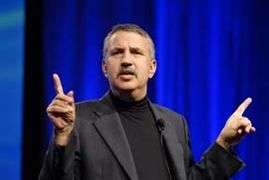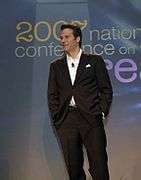Fairfax County Economic Development Authority
The Fairfax County Economic Development Authority (FCEDA) is an independent authority in Fairfax County, Virginia, created under Virginia state law in 1964 and funded by Fairfax County government.[1] The FCEDA exists to promote investment and business growth in Fairfax County in order to expand the commercial tax base that helps pay for public services such as the county school system, police and fire departments, parks, libraries and social services.[2] The FCEDA does this by managing marketing programs that encourage businesses to expand or relocate to the county. It is the largest non-state economic development authority in the nation.[3] Since its founding in 1964, the Fairfax County Economic Development Authority has worked with more than 3,500 companies that added more than 230,000 jobs and leased more 71 million square feet of office space in Fairfax County.[4]
In addition to its marketing programs, the FCEDA provides assistance to existing and new Fairfax County businesses by locating office space, providing market information, linking entrepreneurs with potential investors, and providing liaison services between businesses and Fairfax County regulatory agencies.
The FCEDA also offers monthly workshops for entrepreneurs interested in starting or expanding a business in Fairfax County. Other programs target foreign-owned and small, minority- and woman-owned businesses.
The FCEDA's headquarters are in the Tysons Corner area of Fairfax County, with satellite offices located in Los Angeles, Boston, Bangalore, Munich, London, Seoul and Tel Aviv.[5]
Early history

In 1956 the Fairfax County Board of Supervisors formed an advisory group on economic development called the Industrial Development Commission. This group existed until 1964 when the Virginia General Assembly acted to create the Fairfax County Industrial Development Authority. The legislature changed the name to the Economic Development Authority in 1973.[6] Acting on concerns about population increases and funding of county services, the Board of Supervisors in the late 1970s tasked the FCEDA with its mission to create a business retention and attraction campaign that formed the basis of the EDA's current programs and purpose.
In his book "Internet Alley: High Technology in Tysons Corner, 1945-2005," (The MIT Press, 2008), Paul E. Ceruzzi summarizes two critical events in the history of Fairfax County economic development: the production of the "Noman Cole Report" and the first salvo in what would become an international advertising strategy executed by the Economic Development Authority.
Ceruzzi explains that in 1976 the newly elected chairman of the Fairfax County Board of Supervisors, Jack Herrity, commissioned a Blue Ribbon Panel for the purpose of examining the county's existing ordinances and policies related to industrial development and growth. The panel, named for its chairman, Noman Cole, produced a report entitled the "Committee to Study the Means of Encouraging Industrial Development in Fairfax County."
The Board of Supervisors charged the Economic Development Authority with developing a business attraction and retention program. Earle Williams, one of the contributors to the report, joined the FCEDA Commission around this time and argued for a large increase in the authority's marketing budget. As part of the marketing strategy, the authority bought a two-page ad in The Wall Street Journal, the cost of which was beyond anything that group had ever done, as Ceruzzi notes,.[7] These early forays into advertising were preludes to what would become a robust global advertising effort that would establish Fairfax County as a "brand" unto itself.
The combined impact of pro-growth policies and the attraction and retention campaign (led by the FCEDA advertising program) would prompt Time magazine columnist Justin Fox in 2007 to call Fairfax County "one of the great economic success stories of our time".[8]
Also in 2007, a study called the Long Island Index compared the satisfaction of residents of Long Island and northern Virginia around subjects including local taxes and public services. The survey found that 89 percent of Fairfax County residents were satisfied with the quality of local services and that nearly two out of three northern Virginia residents (Fairfax and Loudoun counties) were satisfied with the value of their property taxes in terms of what they receive in local services. The study also found that 91 percent of Fairfax or Loudoun residents rate their counties as good places to live. Residents in the Virginia counties ranked services, governance and quality of life much higher than did residents of Long Island.[9]
Recent history
In 2005 Site Selection Magazine named the FCEDA to its list of top economic development groups for the EDA's successful efforts to expand the number of defense contractors and research organizations in the county.
Because of its location near the nation's capital, the county has had a large base of government contractors, particularly in the defense and intelligence sectors. Companies in Fairfax County receive more in federal spending than any other county or city in the U.S. In fiscal 2015, companies received $23.1 billion in procurement dollars, about two-thirds of which was related to Department of Defense projects.
Since the turn of the century, however, the FCEDA has made diversification of the county economy one of its major goals. Balancing this employment base with companies not reliant on government procurement became an even more imperative goal in light of federal spending cuts following the Great Recession of 2007 and 2008.
Major corporate relocations involving companies not reliant on federal spending included:
- Volkswagen Group of America, 2007[10]
- Hilton Worldwide, 2009[11]
- Bechtel, 2011[12]
- Intelsat, 2013[13]
Also, Cvent announced in 2015 that it would maintain its headquarters in Fairfax County rather than move elsewhere.
Major defense-related companies or those with significant federal procurement ties also announced they would relocate their headquarters to Fairfax County in this time frame, including:
In 2008 the Washington, D.C.-based International Economic Development Council (IEDC), the largest professional association of economic development practitioners in the world,[17] recognized FCEDA with its 2008 Excellence in Economic Development Award for the FCEDA-produced “Power of Ideas” advertising campaign.[18] The FCEDA received honorable mentions in two other IEDC awards categories in 2008: "Technology-Based Economic Development Program" category for localities with more than 200,000 residents and the "Special Event" category for localities with more than 200,000 residents, for the 2007 National Conference on the Creative Economy.[18]
In April 2010, FCEDA launched a new advertising campaign designed to promote the county's rich quality of life.
The 30-second TV commercial, called “Statistics,” uses brightly animated statistical information on the county – presented through pie charts and other familiar visuals from business presentations – and morphs those shapes into real-life representations of various quality-of-life elements of Fairfax County. The yellow bar of a bar graph becomes a woman's clutch, for example, and the blue wedge of a pie chart is transformed into a slice of pizza. The ad is posted at the FCEDA's video gallery. The TV commercial is the first produced by the FCEDA in a decade. It uses locations at George Mason University and a private home in the Fairfax County community of McLean. The spot, produced by Siddall of Richmond, Va., will run through the end of June on cable outlets in four markets – Boston, Los Angeles, San Francisco and Washington, D.C. – primarily on news and business channels. The “Statistics” campaign also includes print, online and mobile advertising. The ad can also be viewed on YouTube.
In August 2010, the Southern Economic Development Council (SEDC, ) announced that Fairfax County won a 2010 Community Economic Development Award in recognition of its success in business attraction.[19]
FCEDA President Gerald L. Gordon was named 2010 Virginia Business Person of the Year by Virginia Business magazine, which cited his role in helping attract major business headquarters to Fairfax, County as a key factor in their decision.[20] Also in December, the FCEDA was cited as the top economic development project in the state when the Virginia Chamber of Commerce awarded the authority its Virginia Torchbearer award.[21] Gordon has been named to the magazine's "50 most influential Virginians" list every year from 2013-2016.[22]
On July 26, 2014, the Silver Line, the first new Washington Metro rail line since 1991, opened in Tysons Corner, an event the FCEDA's Gordon said will help transform the area in to a "world-class city."[23] The first phase of the Silver Line also includes a stop in the Fairfax County community of Reston.
Governance
The FCEDA operates under the direction of seven commissioners, who are local business people appointed by the Fairfax County Board of Supervisors. The commissioners govern and oversee the FCEDA's policies and programs. Commissioners serve for four-year terms and hire the FCEDA president, who since 1987 has been Gerald L. Gordon, Ph.D.
Gordon is the author of 12 books.[24] His most recent, The Economic Survival of America's Isolated Small Towns, from CRC Press (2015), "provides a detailed discussion of the context of these towns, from the internal challenges that isolate them and force independent action to the extent to which they can rely on neighboring or other macro-level resources." The book is the fourth in a series penned by Gordon and published by CRC Press.
Research and Conferences
The authority conducts research and stages conferences to “better understand broad workplace trends that impact businesses in Fairfax County and across the country.”[25]
The FCEDA organized the 1998 World Conference on Information Technology. Presented by the World Information Technology and Services Alliance and held at George Mason University in Fairfax, the World Congress attracted about 1,900 technology executives and government officials from around the world to discuss trends in the burgeoning information technology sectors. Speakers included former British Prime Minister Margaret Thatcher, former Soviet President Mikhail Gorbachev, and Michael Dell, founder and CEO of Dell Computers. Having the conference located in Fairfax County spotlighted the county as a technology business location.[26]
In September 2007, FCEDA commissioned Ipsos, an independent research firm, to undertake a national poll on creativity in the workplace. The poll found that, while an overwhelming majority of American workers believe they are instinctively creative, fewer than two in three think they are tapping their creative capacities on the job. The results of the national survey were reported on by such publications as the Wall Street Journal, Christian Science Monitor and Washington Post. The poll results were published in advance of the 2007 National Conference on the Creative Economy, a conference presented by the FCEDA. The conference program included keynote addresses from Richard Florida, Thomas Friedman and Alvin Toffler.
In October 2008, the FCEDA commissioned a new survey through Ipsos that examined American workers' opinions of technology in the workplace. The survey found that an overwhelming majority of U.S. workers place a high value on technology in the workplace, so much so that almost 40 percent of employees across the labor force would consider changing jobs to work for an organization that is more committed to providing access to and training in the latest technology. Results of the survey were covered by the Associated Press, the Washington Post and the Fox Business Network.
In May 2009, the FCEDA partnered with Ipsos once again. This time, FCEDA chose to examine issues facing communities that, like Fairfax County, after a long period of suburbanization and increased density, are in transition to a more urban environment. The survey revealed that "living or working in the suburbs might not be all that it’s cracked up to be." Of the one in three (32%) Americans who reportedly live in a suburban environment, a majority (51%) wishes their community had more of a wide variety of offerings. The results of survey were released ahead of the FCEDA conference: “The New Urban Economic Model: The Transformation of Fairfax County" and was picked up by the Washington Business Journal, WTOP and WMAL radio. The conference featured keynote addresses by Urban Land Institute Senior Resident Fellow (and former Indianapolis mayor) William Hudnut and Brookings Institution urban policy scholar Anthony Downs.
In Sept. 2012, the FCEDA presented a symposium titled America’s Aging Workforce, which featured talks from industry and government leaders from the Washington, D.C., area and beyond on a variety of topics related to issues and opportunities presented by demographic shifts in the U.S. workforce.[27] According to FCEDA CEO Gerald Gordon, the number of workers 65 and over will increase 75 percent to 70 million in the next 18 years.[28]
Also presented at the conference were results from a survey looking at how younger and older workers view those demographic shifts.[29] Despite the changing demographics, the research found that different generations value each other's contributions, according to Forbes.[30] Presenters at the conference included John Berry, director of the United States Office of Personnel Management (OPM); John W. Martin, president and CEO of the Southeaster Institute of Research (SIR), co-founder of the Boomer Project and author of Boomer Consumer;[31] Danny Felty, M.D., a healthy-aging expert at HCA Virginia Health System and executives from Fairfax County companies Capital One, Volkswagen Group of America and Balfour Beatty.
References
- "Homepage - Fairfax County, Virginia". fairfaxcounty.gov.
- "About Us — Fairfax County Economic Development Authority".
- "Hilton to Fairfax!". Bisnow.
- Fairfax County, Virginia Fact Sheet
- "The Power of Ideas". fairfaxcountyeda.org.
- "About the FCEDA". Fairfax County Economic Development Authority. Retrieved 18 August 2014.
- High Technology in Tysons Corner, 1945-2005, pp.118-120
- Fox, Justin (February 8, 2008). "The Federal Job Machine". Time Magazine. Retrieved April 25, 2010.
- "A TALE OF TWO SUBURBS: A Case Study Comparing Governance, Taxes and Local Services on Long Island and in Northern Virginia: Executive Summary" (PDF). New York Times.
- Heath, Thomas (2008-05-19). "VW's Move to Herndon Revs Economy". The Washington Post. ISSN 0190-8286. Retrieved 2016-06-27.
- "HILTON TO FAIRFAX! - Real Estate Bisnow (DC) - Bisnow". Bisnow. Retrieved 2016-06-27.
- "Bechtel moving 625 jobs to Fairfax - Washington Business Journal". Washington Business Journal. Retrieved 2016-06-27.
- "Intelsat Confirms Its Move to Tysons -". fairfaxnews.com. Retrieved 2016-06-27.
- Pae, Peter (2008-01-31). "CSC to leave El Segundo". Los Angeles Times. ISSN 0458-3035. Retrieved 2016-06-27.
- "SAIC Officially Relocates HQ to McLean VA | Xconomy". 2009-09-24. Retrieved 2016-06-27.
- Censer, Marjorie; O'Connell, Jonathan (2010-07-13). "Northrop picks headquarters building in Fairfax County". The Washington Post. ISSN 0190-8286. Retrieved 2016-06-27.
- "Frequently Asked Questions About IEDC". International Economic Development Council. Retrieved April 26, 2010.
- "IEDC Winners PDF" (PDF). Archived from the original (PDF) on 2011-07-17. Retrieved 2008-10-28.
- http://sedc.affiniscape.com/associations/10243/files/CEDA%20Winners%20for%20Web%20site.pdf%5B%5D
- "The ace pitcher". virginiabusiness.com.
- "Fairfax County Economic Development Authority wins state award". virginiabusiness.com.
- "High-wattage personalities · Industries | Virginia Business". www.virginiabusiness.com. Retrieved 2016-06-27.
- "Silver Line opening will be a boon for Northern Virginia". Washington Times.
- "Gerald L. Gordon, Ph.D." Fairfax County Economic Development Authority.
- "Archived copy". Archived from the original on 2010-11-25. Retrieved 2011-01-03.CS1 maint: archived copy as title (link)
- "A History of Mason".
- "Fairfax County EDA symposium addresses challenges, opportunities posed by America's aging workforce". fairfaxcountyeda.org.
- "The shift is on: Lessons from America's quickly aging workforce". Richmond.com.
- "As workforce ages, surprising degree of generational harmony, not conflict, exists in the workplace". fairfaxcountyeda.org.
- Hannon, Kerry. "How To Fight Age Discrimination". Forbes.
- "Boomer Consumer :: New Book from the Boomer Project". boomerconsumer.com.



